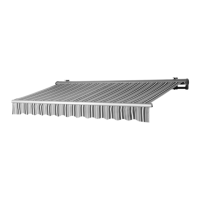9
• MANUAL OPERATION. Manual operation is used when the power is not connected. It does not
work when the power is connected.
• WARNING: Exercise caution when operating manually. The awning can extend quickly if the
springs are weak or broken.
Crank handle
Eye
Manual operation may only be performed using the hand crane. Insert the hand crank’s hook in
the eye. Rotate clockwise to extend the awning canopy and anticlockwise to retract it.
Manual operation is only intended as a reserve function to be used in the event
of a power failure. The awning should not normally be operated manually. Manual
operation over an extend time can damage the motor.
The awning may not be operated manually when the power is connected.
• The awning’s valance can be easily removed if you prefer the awning without it.
MAINTENANCE
• Regular maintenance is important for safety purposes and for extending the service life of the
awning.
• Avoid stains on the awning. The awning should be clean and dry when retracted. If it is retracted
while it is wet, it should be extended as soon as possible in order to allow it to dry.
• Check regularly to ensure that the awning’s wires are not damaged. Do not use the awning if the
wires are not in good condition.
• Check regularly to ensure that the wall brackets are securely fastened.
• Inspect the screws and nuts twice per year. Tighten them if they are loose.
• Do not use the awning if it is damaged or if it is not properly fastened. Contact an authorised
technician for repairs.
• Under normal circumstances it is not necessary to lubricated the moving parts of the awning.
If lubrication is necessary, petroleum based lubricants may not be used.
• When lubricating, use a spray nozzle with tube. Thoroughly lubricate the area between the end
of the supporting bar and the bracket. Avoid spraying the awning canopy.

